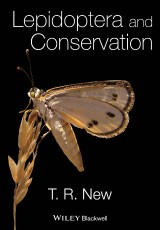Details

Lepidoptera and Conservation
1. Aufl.
|
60,99 € |
|
| Verlag: | Wiley-Blackwell |
| Format: | EPUB |
| Veröffentl.: | 13.09.2013 |
| ISBN/EAN: | 9781118409251 |
| Sprache: | englisch |
| Anzahl Seiten: | 280 |
DRM-geschütztes eBook, Sie benötigen z.B. Adobe Digital Editions und eine Adobe ID zum Lesen.
Beschreibungen
The third in a trilogy of global overviews of conservation of diverse and ecologically important insect groups. The first two were <i>Beetles in Conservation</i> (2010) and <i>Hymenoptera and Conservation</i> (2012). Each has different priorities and emphases that collectively summarise much of the progress and purpose of invertebrate conservation. <br /> <br /> Much of the foundation of insect conservation has been built on concerns for Lepidoptera, particularly butterflies as the most popular and best studied of all insect groups. The long-accepted worth of butterflies for conservation has led to elucidation of much of the current rationale of insect species conservation, and to definition and management of their critical resources, with attention to the intensively documented British fauna ‘leading the world’ in this endeavour. <br /> <br /> In <i>Lepidoptera and Conservation</i>, various themes are treated through relevant examples and case histories, and sufficient background given to enable non-specialist access. Intended for not only entomologists but conservation managers and naturalists due to its readable approach to the subject.
Preface viii <p>Acknowledgements xiii</p> <p><b>1 Lepidoptera and Invertebrate Conservation 1</b></p> <p>Introduction 1</p> <p>Biological background 3</p> <p>Sources of information 11</p> <p><b>2 The Diversity of Lepidoptera 16</b></p> <p>Introduction 16</p> <p>Distinguishing taxa 19</p> <p>Drivers of diversity 28</p> <p><b>3 Causes for Concern 32</b></p> <p>Introduction: Historical background 32</p> <p>Extinctions and declines 33</p> <p><b>4 Support for Flagship Taxa 40</b></p> <p>Introduction 40</p> <p>Community endeavour 41</p> <p>Flagships 44</p> <p><b>5 Studying and Sampling Lepidoptera for Conservation 48</b></p> <p>Introduction 48</p> <p>Sampling methods 50</p> <p>Interpretation for conservation 64</p> <p>Priorities amongst species 66</p> <p>Priority for conservation 71</p> <p>Species to areas 76</p> <p>Critical faunas 82</p> <p>Related approaches 85</p> <p><b>6 Population Structures and Dynamics 94</b></p> <p>Introduction: Distinguishing populations 94</p> <p>Metapopulation biology 97</p> <p>Vulnerability 108</p> <p><b>7 Understanding Habitats 117</b></p> <p>Introduction: The meaning of ‘habitat’ 117</p> <p>Habitat loss 123</p> <p><b>8 Communities and Assemblages 142</b></p> <p>Introduction: Expanding the context 142</p> <p>‘Vulnerable groups’ 144</p> <p>Habitats and landscapes 147</p> <p>Assessing changes 152</p> <p>Forests 152</p> <p>Agriculture 153</p> <p>Urbanisation 155</p> <p><b>9 Single Species Studies: Benefits and Limitations 161</b></p> <p>Introduction 161</p> <p>Some case histories 168</p> <p>The Large blue butterfly, Maculinea arion, in England 169</p> <p>The Large copper butterfly, Lycaena dispar, in England 170</p> <p>The Brenton blue butterfly, Orachrysops niobe, in South Africa 172</p> <p>The Richmond birdwing butterfly, Ornithoptera richmondia, in Australia 173</p> <p>The Golden sun-moth, Synemon plana, in south-eastern Australia 174</p> <p>The New Forest burnet moth, Zygaena viciae, in Scotland 175</p> <p>The Essex emerald moth, Thetidia smaragdaria maritima, in England 176</p> <p>The Fabulous green sphinx of Kaua’i, Tinostoma smaragditis, in Hawai’i 177</p> <p>Blackburn’s sphinx moth, Manduca blackburni, in Hawai’i 177</p> <p>Variety of contexts 179</p> <p><b>10 Ex Situ Conservation 183</b></p> <p>Introduction: Contexts and needs 183</p> <p>Lepidoptera in captivity 187</p> <p>Inbreeding 188</p> <p>Pathogens 189</p> <p>Translocations and quality control 190</p> <p>Assisted colonisation 192</p> <p><b>11 Lepidoptera and Protective Legislation 197</b></p> <p>Introduction 197</p> <p>Prohibition of collecting 201</p> <p><b>12 Defining and Alleviating Threats: Recovery Planning</b> <b>206</b></p> <p>Introduction: The variety of threats to Lepidoptera 206</p> <p>Alien species 207</p> <p>Diseases 209</p> <p>Climate change 210</p> <p>Exploitation for human need 214</p> <p>Light pollution 217</p> <p>Pesticides 218</p> <p>Habitat manipulation and management 219</p> <p>Grazing 225</p> <p>Mowing 228</p> <p>Coppicing 229</p> <p>Burning 229</p> <p><b>13 Assessing Conservation Progress, Outcomes and Prospects 241</b></p> <p>Introduction 241</p> <p>Monitoring conservation progress 242</p> <p>Indicators 246</p> <p>Future priorities and needs 255</p> <p>Index 260</p>
<p>“For this reason, it will serve as an important introduction to Lepidoptera conservation for graduate students and biologists, as well as a reference for conservation practitioners.” (<i>The Quarterly Review of Biology</i>, 1 December 2015)</p> <p>“As with New’s previous books, this is well written, easy-to-understand, comprehensive, and highly organized, providing a valuable overview of the challenges and goals associated with conservation efforts. Summing Up: Highly recommended. Upper-division undergraduates and above; general readers.” (<i>Choice</i>, 1 October 2014)</p> <p> </p>
<b>Tim New</b> is Emeritus Professor in the Department of Zoology, La Trobe University, Melbourne. He has written extensively on insectconservation, including volumes on Hymenoptera (2012) and beetles (2010) both published by Wiley-Blackwell. An entomologist with wide interests in insect conservation, systematics and ecology, he is recognised as one of the leading advocates for the importance of insects in conservation.
<p>Lepidoptera, the butterflies and moths, is the leading flagship group for advancing interest in insect conservation. One of the largest insect orders, with numerous intricate ecological interactions, their long aesthetic attraction to naturalists and collectors has contributed to a unique cumulative historical record of information on diversity, biology, habitat relationships, distribution, and interactions with people. Collectively, this information has ensured that many declines and extinctions of species – particularly of butterflies in the northern hemisphere – have been brought forcefully and unambiguously to human notice. Both theoretical and practical aspects of their conservation have proliferated in recent decades, and the relevant scientific literature on Lepidoptera ecology and conservation (both peer-reviewed and in unpublished reports) continues to burgeon in extent and complexity.</p> <p>This book is a global overview of Lepidoptera conservation and its roles in providing lessons for wider insect conservation. It brings together some of the highly scattered information into a synthesis for research workers, conservation managers, naturalists and students, in a manner that assumes little previous knowledge, and provides a substantial list of relevant references for further information. The book emphasises the contrasts between the progress possible for the better-documented northern temperate regions and for the rest of the world, but examples and cases noted demonstrate also the increasing urgency and novel initiatives that continue to develop.</p>

















